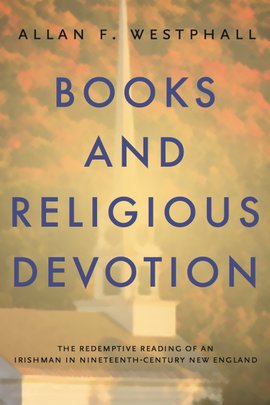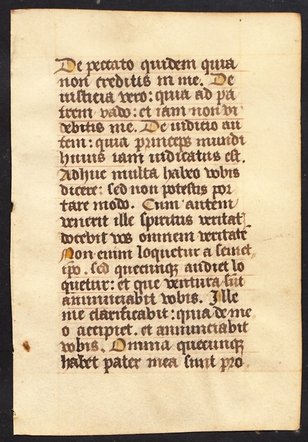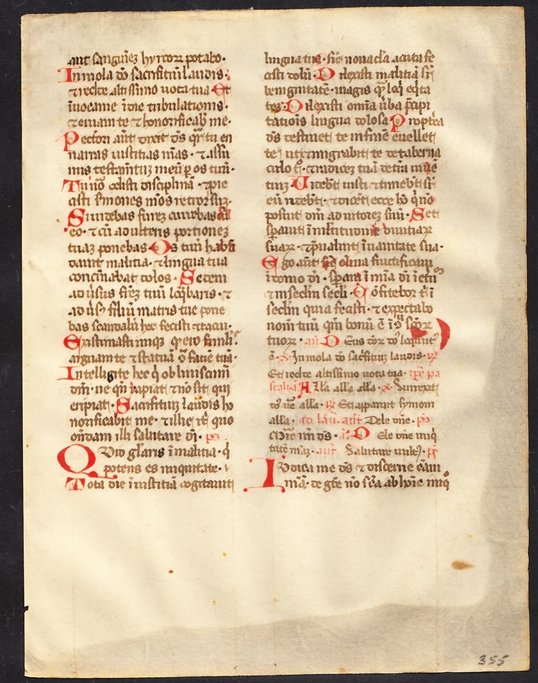Academic interests
Two scraps of a medieval manuscript salvaged from the binding of a 16th century copy of the pseudo-Bonaventuran Meditationes Vitae Christi.
I use this page to share some of my academic interests and ongoing projects, mostly in the area of late medieval literature and culture. The illustrations are from my very small collection of medieval manuscript fragments and leaves.
My research interests
My research focuses on the religious culture in the late medieval period, c. 1350-1550. I am particularly interested in Middle English religious and mystical writing, performance and affective forms of devotion, religious lyric religious, religious drama, Lollardy and heresy, medieval theology and intellectual history in general. With Ian Johnson from the University of St Andrews I have published a volume of essays entitled The Pseudo-Bonaventuran Lives of Christ: Exploring the Middle English Tradition. This publication investigates the literary tradition of Middle English Lives of Christ in its cultural, theological, and manuscript contexts. A related research interest is in the areas of book history and the history of reading. Some of my most recent research consists of a number of case studies that looks at the book collections and reading practices of a Catholic community in nineteenth-century New Hampshire. This has appeared as Books and Religious Devotion: The Redemptive Reading of an Irishman in Nineteenth Century New Hampshire (Penn State University Press, 2014).
Teaching
I have taught at universities in Poland, Denmark, and the University of St Andrews. My teaching has focused on subjects of medieval and early modern literature, from Old English writing to John Milton. I have also taught survey courses on British literature from the Anglo Saxon period to the present, and contributed to seminars on literary theory and the history of the English language.
Qualifications
BA Aarhus University (English & Philosophy), 1995
MA Aarhus University, English Language and Literature,1998
MA Queen's University Belfast (English Medieval Studies), 1999
PhD Aarhus University (English Medieval Literature), 2007
PostDoc University of St Andrews, 2007-11
With the Reformation (often proclaimed as the triumph of the printed book) it was common for discarded medieval manuscript to be cut up and used as part of book bindings.
Publications:
Books
- Books and Religious Devotion: The Redemptive Reading of an Irishman in Nineteenth Century New England (Philadelphia: Penn State University Press, 2014)
- Allan Westphall and Ian Johnson, ed, The Pseudo-Bonaventuran Lives of Christ: Exploring the Middle English Tradition (Turnhout: Brepols, 2013).
Articles
-
‘A Borrowing from Eadmer of Canterbury’s Liber de excellentia virginis Mariae in a Medieval English Translation of the Meditationes vitae Christi’, Notes and Queries, forthcoming.
- 'An English Book Treasure in The Royal Library, Copenhagen: Thomas Speght's Edition of the Works of Geoffrey Chaucer', Fund og Forskning, forthcoming. (in Danish)
- 'The Postal History of Batavia Forwarding Agents', The London Philatelist, forthcoming 2022.
- 'The Franciscan Stimulus Amoris in Counter-Reformation Controversy: The Recusant Goad of Divine Love, Douai, 1642', Franciscan Studies, 79 (2021), 259-286.
- 'Forwarding and Duplication in Nineteenth-Century International Mail', The London Philatelist, 131 (2021), 49-60.
- (with Ryan Perry) ‘‘Presarve the good corne by gathering oute the wedes’: Hospitable Readings of the Pricking of Love in Sixteenth-Century England', Journal of Medieval and Early Modern Studies, 48, 2 (2018), 301-340.
- 'The Culture of the Duplicate Letter: An Aspect of Nineteenth Century Letter Writing', The London Philatelist, 126 (2017), 2-14.
- ‘The Passion in English: Meditations on the Life of Christ in Michigan State University MS 1’, Neophilologus, 97, 1 (2013), 199-214.
- ‘On Not Melting into Tears: Managing Meditative Reading in Michigan State University Library MS 1 and Cambridge, Magdalene College MS Pepys 2125’, Medium Aevum, 84, 1 (2015), 40-66.
- 'W. H. Medhurst, Missionary in Java and China: The Meeting of Postal and Social History in a Letter from 1842', Collectors Club Philatelist, 94 (2015), 228-37.
- ‘‘I am here’: Reading Julian of Norwich in Nineteenth Century New England, The Medieval Journal, 3, 2 (2013), 137-68.
- ‘Walter Hilton’s The Pricking of Love and the Construction of Vernacular ‘Sikernesse’’, in The Pseudo-Bonaventuran Lives of Christ, ed. by Johnson and Westphall (Turnhout: Brepols, 2013), 457-502.
- ‘Reginald Pecock’, in The Oxford Guide to the Historical Reception of Augustine, 3 vols (Oxford: Oxford University Press, 2013), I, pp. 1024-27.
- ‘Reconstructing the Mixed Life in Reginald Pecock’s The Reule of Crysten Religioun’, in After Arundel: Religious Writing in Fifteenth-Century England, ed. by Vincent Gillespie and Kantik Ghosh (Turhout: Brepols, 2011), pp. 267-84.
- ‘‘Labouring in my Books’: A Religious Reader in Nineteenth-Century New Hampshire’, Library: Transactions of the Bibliographical Society, 13, 2 (2012), 185-204.
- "‘Contemplation and Linguistic Reflection in the Middle English The Cloud of Unknowing’', Passage: Journal of Literature and Criticism 51 (2004), 31-45.
- ‘Issues of Personification and Debate in Wynnere and Wastoure’, English Studies 82, 6 (2001), 481-96.
Chapters in books
- ‘The Bonaventuran Franchise: Mapping A Middle English Textual Tradition’, in Geographies of Orthodoxy.
Creative Writing
- 'Tempest and Nebula; or A Trip to the Peak', in After the Storm (Hong Kong: Hong Kong Writers Circle, 2021), 253-271.
- 'Living with the Gods', in A Book of Changes (Hong Kong: Hong Kong Writers Circle, 2022), 183-197.
Books and Religious Devotion is a study of a remarkable book collection of a nineteenth-century New England farmer, Thomas Connary. Through a detailed reconstruction of how this Irish Catholic immigrant read and annotated his books, the study gives new insight into the capacity of books for structuring a life of devotion and social participation, and it presents an authentic and holistic view of one reader’s interior life.
This is a collection of pioneering studies by a distinguished transatlantic team of scholars on a neglected yet canonical tradition of medieval English literature. From the fourteenth to the sixteenth centuries and beyond, the remarkable ‘pseudo-Bonaventuran’ tradition, flowing from the Latin Meditationes vitae Christi (and thought, wrongly, to have been composed by St Bonaventure), gave Europe orthodox models for how to represent, know, and follow Jesus Christ. How to live, what to believe, how to feel, and how to be saved: this eloquent mainstream tradition had an impact on the public and private lives of English people more profound and lasting than any text save the Bible itself. For many, it even did the Bible’s work. The tradition of the Meditationes provides us with a gauge of lived religious sensibility without equal in the English later Middle Ages.







